If the ride from Bukit Lawang was rough, the transfer on to Berastagi in Medan was so smooth my feet barely touched the floor as I was hustled from one bus to another - I didn't even get to touch my rucksack. Three hours later - most of it in torrential rain with a significant proportion of this draining through the roof onto my shoulder - and a good deal of slow uphill motoring, and I arrived in the central agricultural town of Sumatra's northern Karo highlands - some 1500m above sea level and deliciously cool after the heat of Medan.
On the Sumatra backpacker trail - or at least what exists of it - Berastagi is often skipped as having little do. However, the climate and lack of hassle you get adds another dimension - that was worth at least a couple of days. In my guesthouse I met Janick and Inge, two Dutch girls on the last leg or their Indonesia trip, and we booked a day-long tour of the Berastagi area.
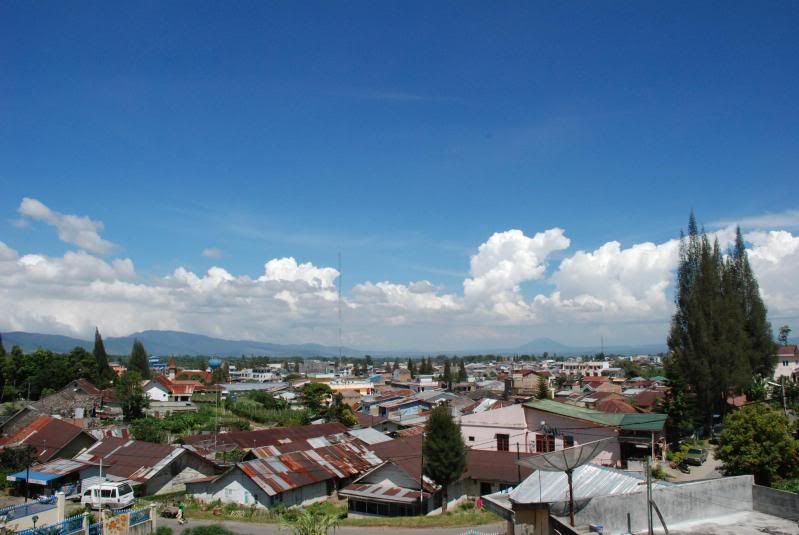
The country around Berastagi is recognised not only for it's amazing vegetable growing potential (more interesting for some than others) and also the Karo Batak people who live there. The Karo Batak have a distinctive style of house which is now dying out, but can still be seen in a few traditional villages. There are also a few active volcanoes in the area - as per usual, trips to climb them (and finish in the hot springs at the bottom) are common.
Something that had not bothered me until Berastagi was the call to prayer each morning, aired from the speakers of minarets in mosques all over Indonesia around 4.30am. In Medan, with a huge and famous mosque, I had slept through it much to peoples amazement. In Berastagi, you couldn't. The call to prayer can be a tremendously evocative part of travel in a Muslim region, as long as it is done well. Sadly, in Berastagi the muezzin sounded something like the cat that had been wailing outside my door for the other part of the night - it was not a particularly restful sleep. What was more suprising was that Berastagi was the first region we had visited where the population were predominantly Christian - churches abounded.
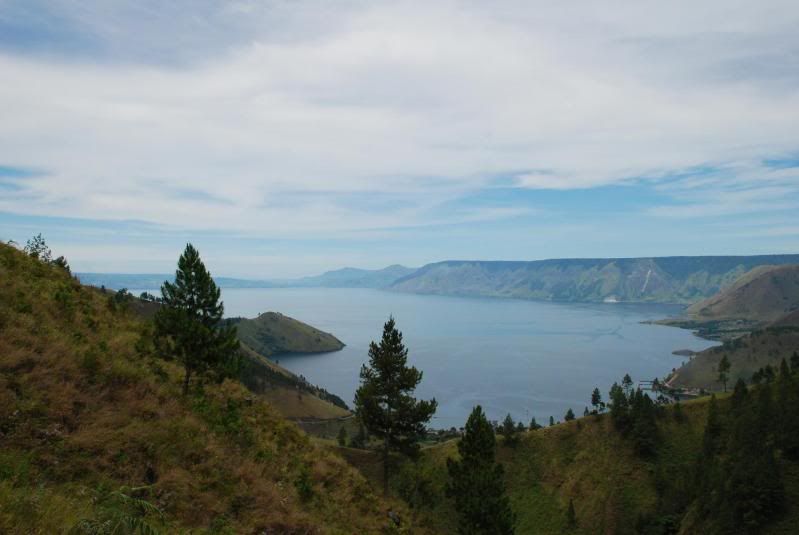
Our trip started at Se Piso Piso waterfall at northern end of Lake Toba - more about that below - where it plunges 120m to land somewhat closer to the lake than it started. It was impressive, aside from the usual litter and graffiti associated with most Indonesian landmarks. It was also pretty close to where we would head after leaving Berastagi - not the best in forward planning, but there you go.
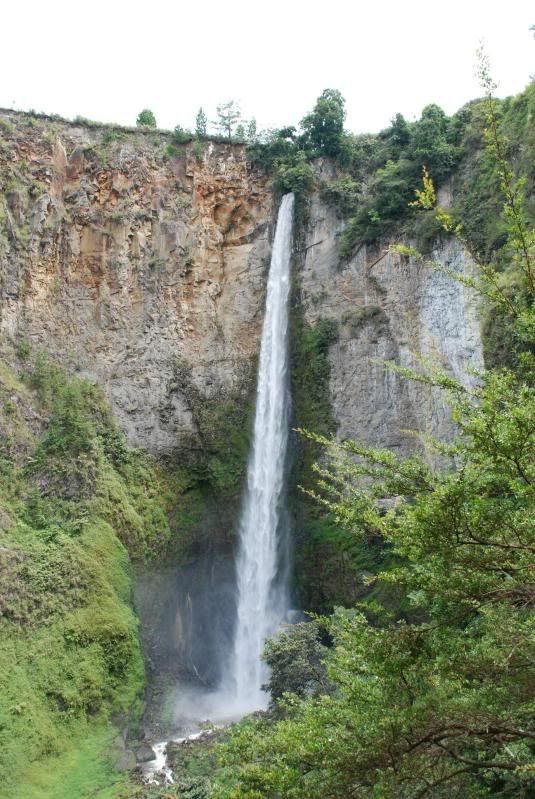
We stopped in the Karo Batak village of Dokan, where there were a few traditionally designed and roofed houses left standing (and in use). The presence of satellite dishes and new-build brick and concrete houses was testament to the headlong rush into modernisation, although after a look through one of the dark, smoke-filled and musty houses that was home to 8 families, you couldn't really blame them.
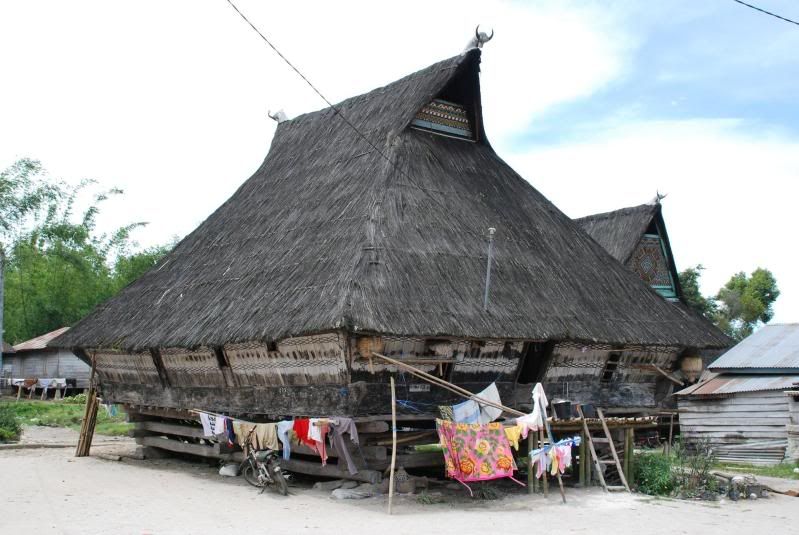
It was the first time in Indonesia that I had seen anything like a traditional dress worn by many people - mostly the older women who wore a distinctive head dress to protect from the sun. They also spent a lot of time chewing betel nut - the site of a 50-something woman drooling red juice with a large gobstopper in her mouth was particularly common. Tourists were also pretty uncommon, judging by the numbers of "Hello mister" greetings and the regularity of being stopped by school children for an English interrogation.
Our final stop on the day tour was at some hot springs at the base of Mount Sibayak, one of two volcanoes that towers over Berastagi - both are still slightly active. The hot springs seemed a little unusual - there was not the overwhelming reek of sulphur to start with - and many locals were there enjoying the warm water whilst covering themselves with whitening pastes of various kinds. The whitening phenomenon is common across Asia where as far as skin goes, the whiter the better. For me, the most surprising element of this is that locals do not use suncream to stop themselves from turning a darker colour, but use various creams, potions and lotions after sun exposure to make themselves whiter again..... with questionable results.
After another day in Berastagi, trying to upload photos to the internet and tearing my hair out at the same time, we left for Lake Toba in a car hired between us and couple of American guys we had met. After winding our way back almost back to the waterfall, we headed down the east side of the lake to Parapat, a small town on the Trans Sumatran Highway that sits on the edge of the lake.
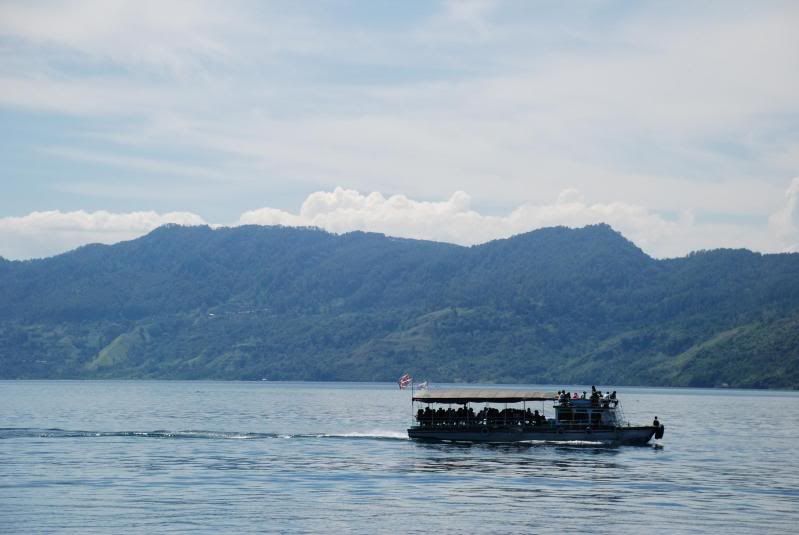
Lake Toba is the largest body of freshwater in Southeast Asia, some 60km long and nearly 20km wide in places. It is an old volcanic crater (and the world's biggest crater lake at that) which makes for spectacular scenery and some very refreshing swimming. Within the lake is the "island" of Samosir (actually linked by a narrow isthmus to the crater wall), upon which is found the Tuk Tuk peninsula, home of the majority of tourist places in the area. Back in the day when Sumatra was a big feature on the backpacker trail, Tuk Tuk was chief party spot for all of South East Asia. The local Batak people (different from the Karo Batak) enjoyed drinking, making music and generally having a good time - an agreeable coincidence for many likeminded backpackers.
Nowadays, Tuk Tuk's numerous guesthouses and hotels lie mostly empty, restaurants are relieved when they have a single table full in the evening, and souvenir shops are almost on a self service basis. The crowds have departed for Koh Phangnan's full moon parties, and the trickle of foreign tourists and weekend trippers from Medan cannot make up those numbers.
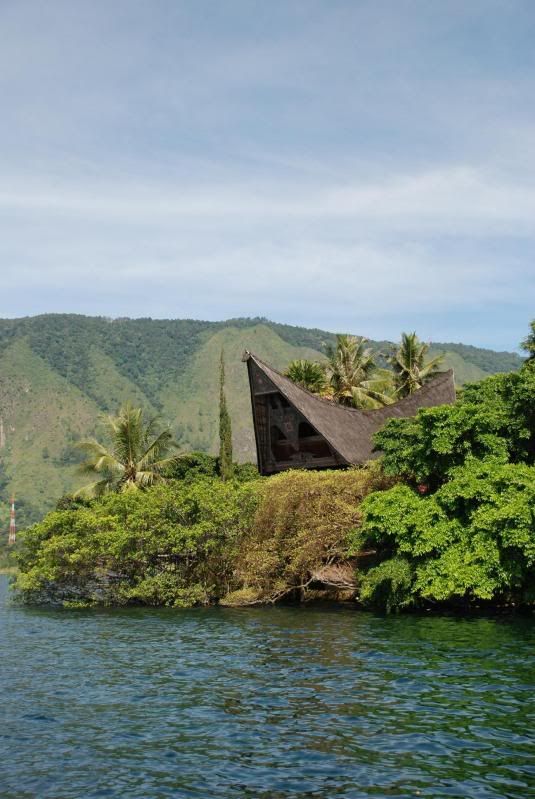
We booked ourselves into Hotel Carolina, chiefly for it's good swimming spot although the flushing toilets and hot water were not to be sniffed at. The good rooms were a little over-the-average price, but the basic ones at US$2 a night were a bargain - our American friends decided the latter were a better option, whereas I was craving my first hot shower for a couple of weeks and went expensive (US$8 per night).
Tuk Tuk and Samosir islands are big enough to warrant a set of wheels to get around, so I rented a moped for a few days to cruise around Tuk Tuk and explore the northern parts of Samosir. Although the lake is comparatively young - some 70,000 years - remains of megalithic cultures exist at Ambarita, just north of Tuk Tuk. Here, amongst the traditional Batak houses (very different to the Karo Batak style) are two sets of stone chairs where village elders used to discuss matters. Local history recounts that villagers where also tried for misdemeanours here; those found guilty were moved to the second set of chairs where their skin was sliced and rubbed with chilli and garlic, before they were beheaded in a very savoury death; historians are little more unsure about whether the unfortunate were then eaten with a portion of sticky rice.
On the Sumatra backpacker trail - or at least what exists of it - Berastagi is often skipped as having little do. However, the climate and lack of hassle you get adds another dimension - that was worth at least a couple of days. In my guesthouse I met Janick and Inge, two Dutch girls on the last leg or their Indonesia trip, and we booked a day-long tour of the Berastagi area.

The country around Berastagi is recognised not only for it's amazing vegetable growing potential (more interesting for some than others) and also the Karo Batak people who live there. The Karo Batak have a distinctive style of house which is now dying out, but can still be seen in a few traditional villages. There are also a few active volcanoes in the area - as per usual, trips to climb them (and finish in the hot springs at the bottom) are common.
Something that had not bothered me until Berastagi was the call to prayer each morning, aired from the speakers of minarets in mosques all over Indonesia around 4.30am. In Medan, with a huge and famous mosque, I had slept through it much to peoples amazement. In Berastagi, you couldn't. The call to prayer can be a tremendously evocative part of travel in a Muslim region, as long as it is done well. Sadly, in Berastagi the muezzin sounded something like the cat that had been wailing outside my door for the other part of the night - it was not a particularly restful sleep. What was more suprising was that Berastagi was the first region we had visited where the population were predominantly Christian - churches abounded.

Our trip started at Se Piso Piso waterfall at northern end of Lake Toba - more about that below - where it plunges 120m to land somewhat closer to the lake than it started. It was impressive, aside from the usual litter and graffiti associated with most Indonesian landmarks. It was also pretty close to where we would head after leaving Berastagi - not the best in forward planning, but there you go.

We stopped in the Karo Batak village of Dokan, where there were a few traditionally designed and roofed houses left standing (and in use). The presence of satellite dishes and new-build brick and concrete houses was testament to the headlong rush into modernisation, although after a look through one of the dark, smoke-filled and musty houses that was home to 8 families, you couldn't really blame them.

It was the first time in Indonesia that I had seen anything like a traditional dress worn by many people - mostly the older women who wore a distinctive head dress to protect from the sun. They also spent a lot of time chewing betel nut - the site of a 50-something woman drooling red juice with a large gobstopper in her mouth was particularly common. Tourists were also pretty uncommon, judging by the numbers of "Hello mister" greetings and the regularity of being stopped by school children for an English interrogation.
Our final stop on the day tour was at some hot springs at the base of Mount Sibayak, one of two volcanoes that towers over Berastagi - both are still slightly active. The hot springs seemed a little unusual - there was not the overwhelming reek of sulphur to start with - and many locals were there enjoying the warm water whilst covering themselves with whitening pastes of various kinds. The whitening phenomenon is common across Asia where as far as skin goes, the whiter the better. For me, the most surprising element of this is that locals do not use suncream to stop themselves from turning a darker colour, but use various creams, potions and lotions after sun exposure to make themselves whiter again..... with questionable results.
After another day in Berastagi, trying to upload photos to the internet and tearing my hair out at the same time, we left for Lake Toba in a car hired between us and couple of American guys we had met. After winding our way back almost back to the waterfall, we headed down the east side of the lake to Parapat, a small town on the Trans Sumatran Highway that sits on the edge of the lake.

Lake Toba is the largest body of freshwater in Southeast Asia, some 60km long and nearly 20km wide in places. It is an old volcanic crater (and the world's biggest crater lake at that) which makes for spectacular scenery and some very refreshing swimming. Within the lake is the "island" of Samosir (actually linked by a narrow isthmus to the crater wall), upon which is found the Tuk Tuk peninsula, home of the majority of tourist places in the area. Back in the day when Sumatra was a big feature on the backpacker trail, Tuk Tuk was chief party spot for all of South East Asia. The local Batak people (different from the Karo Batak) enjoyed drinking, making music and generally having a good time - an agreeable coincidence for many likeminded backpackers.
Nowadays, Tuk Tuk's numerous guesthouses and hotels lie mostly empty, restaurants are relieved when they have a single table full in the evening, and souvenir shops are almost on a self service basis. The crowds have departed for Koh Phangnan's full moon parties, and the trickle of foreign tourists and weekend trippers from Medan cannot make up those numbers.

We booked ourselves into Hotel Carolina, chiefly for it's good swimming spot although the flushing toilets and hot water were not to be sniffed at. The good rooms were a little over-the-average price, but the basic ones at US$2 a night were a bargain - our American friends decided the latter were a better option, whereas I was craving my first hot shower for a couple of weeks and went expensive (US$8 per night).
Tuk Tuk and Samosir islands are big enough to warrant a set of wheels to get around, so I rented a moped for a few days to cruise around Tuk Tuk and explore the northern parts of Samosir. Although the lake is comparatively young - some 70,000 years - remains of megalithic cultures exist at Ambarita, just north of Tuk Tuk. Here, amongst the traditional Batak houses (very different to the Karo Batak style) are two sets of stone chairs where village elders used to discuss matters. Local history recounts that villagers where also tried for misdemeanours here; those found guilty were moved to the second set of chairs where their skin was sliced and rubbed with chilli and garlic, before they were beheaded in a very savoury death; historians are little more unsure about whether the unfortunate were then eaten with a portion of sticky rice.
The volcanic soil of the area provides very fertile land for rice growing, and a large part of Samosir is taken over with rice paddies. Rice harvesting seems to occur all year round; after harvesting and threshing, the rice straw is then burnt which provides most of Sumatra with a pale haze for much of the year - Malaysia makes yearly complaints as the smoke drifts across the Melaka Straits.
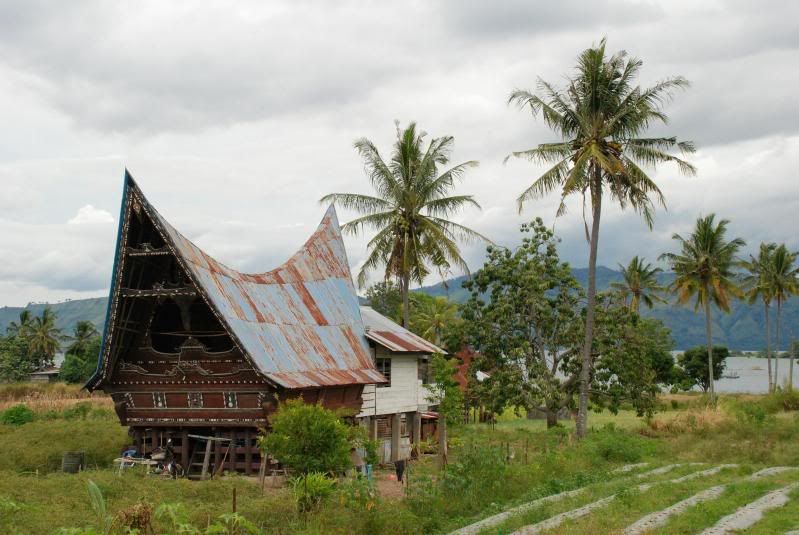

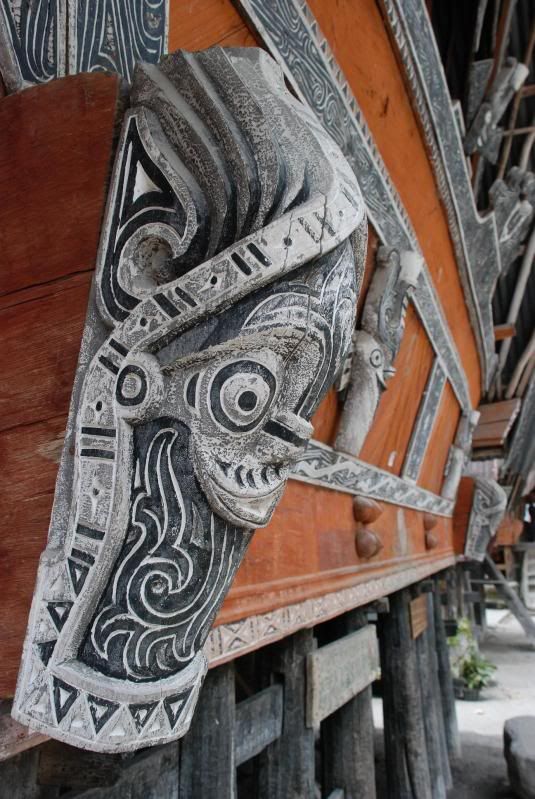
Detail on a traditional Batak house
By night, Tuk Tuk was a strange, almost lonely experience. Gone were the days where bars thronged with hedonistic backpackers willing to try the abundant local magic mushrooms; instead there were empty restaurants where an sleepy owner had to be found somewhere down the back on a mattress that had seen better days. I decided to forgoe the dubious temptation of "Special Mushroom Omlette" or "Special Mushroom Tea" - clearly the mushrooms hadn't demised along with the tourism. Janick and Inge were keen to see what the local disco had to offer, so we walked up to a place of pounding house music and flashing lights, encircled by a few mopeds. Walking in we found perhaps the entire 18-25 population of males from Tuk Tuk; Janick and Inge found their curiosity dried up as fast as the local's was aroused and we left in short order, never to return.
All that is not to say Lake Toba does not have charm - it does, albeit rather sleepy. There are lovely Batak houses, beautiful rice fields, many restaurants to sit in solitude gazing out over the lake whilst reading a book and sipping a fruit shake. But after 5 days it was enough for all of us, so we headed back to Parapat and caught the night bus to Bukittingi, several hundred further kilometres south.
The bus ride was distinctly average. Sitting at the back of the bus next to the toilet, I had a friendly Belgian guy on one side, and a local woman with her hyperactive toddler on the other. It had aircon which was promptly turned onto "refrigerate" setting, and a thankful lack of karaoke machines. The Trans-Sumatran highway, for most of the 15 hour journey, would have been more aptly named the Trans-Sumatran farm track; once the child next to me settled down with hypothermia I lent the mother my sarong to keep the little nipper warm - she promptly vomited on her child and used my sarong to wipe it up (and didn't tell me). As I said, average.
Bukittingi is another town with guide-overload and tourist underload; even as we headed up to a cafe from the bus terminal for breakfast, we were "shown" in by a guy who had followed us up the other side of the street then acted like he brought us there, earning himself a little commission in the process. Bukittingi is a fairly unremarkable town but it's surroundings are much nicer - very similar to Berastagi. After a kip our little gang - 3 Belgian lads, Inge, Janick and myself - headed around the market, which saw few enough white people to make this an absolutely hilarious occurrence for many. Once again, the fresh chicken was available "while-u-wait" - simply pick your chicken as it pecks around the cage, look the other way and... hey presto! A fully sliced and diced chicken.... "would you like the giblets with that mister???"
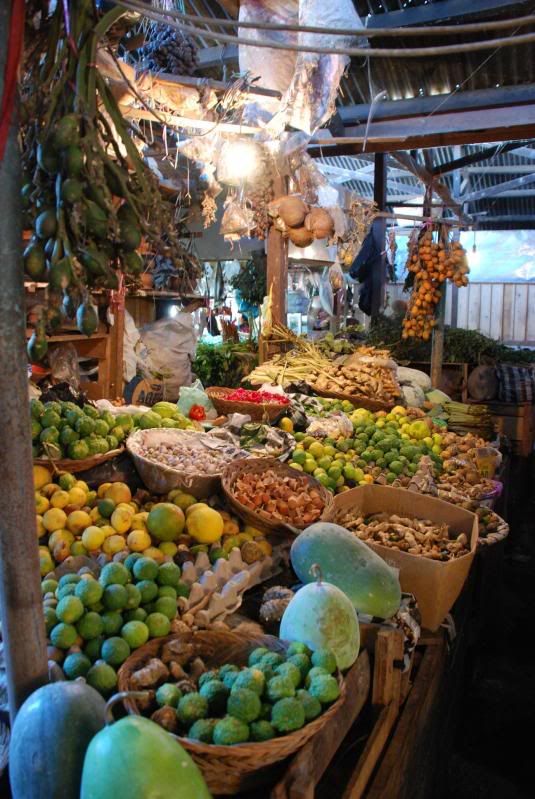
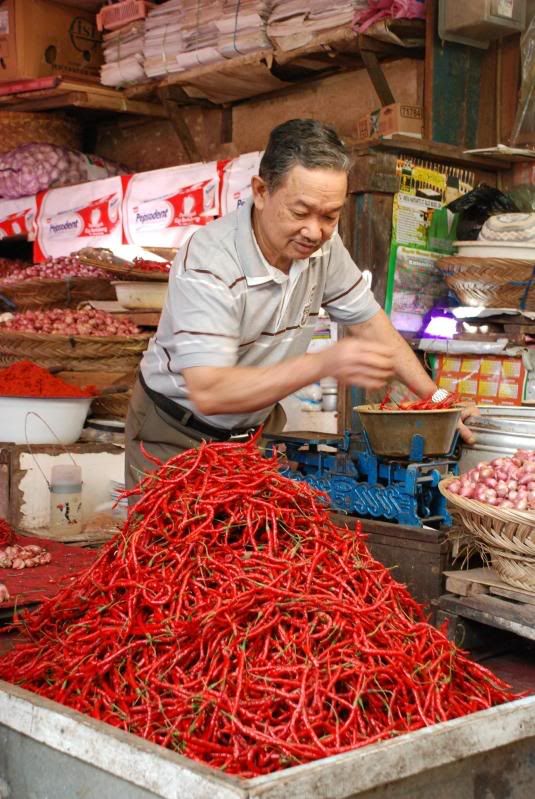
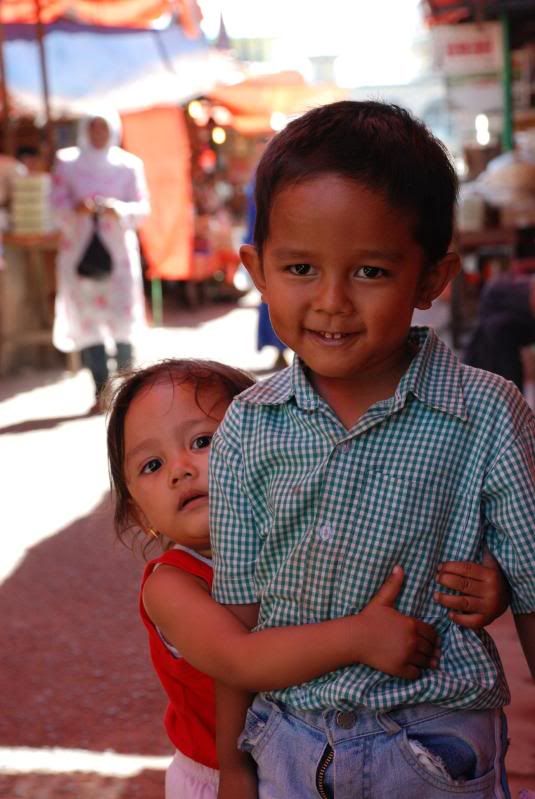
After the Belgian boys moved on and I washed my sarong and slept, I headed off with the girls on a day tour of the area with Fikar, a local guide who worked from a cafe as part of a co-op - we were happy to give him our money. The girls went as passengers on motorbikes; I had my own and we were soon cruising through rice paddies on our way to the Harau Valley, a spectacularly picturesque valley made of some kind of rock that I can't remember. Fikar was pleased that I seemed to be able to drive faster than 40km/h, even whilst wearing a comedy helmet made mostly of duct tape.
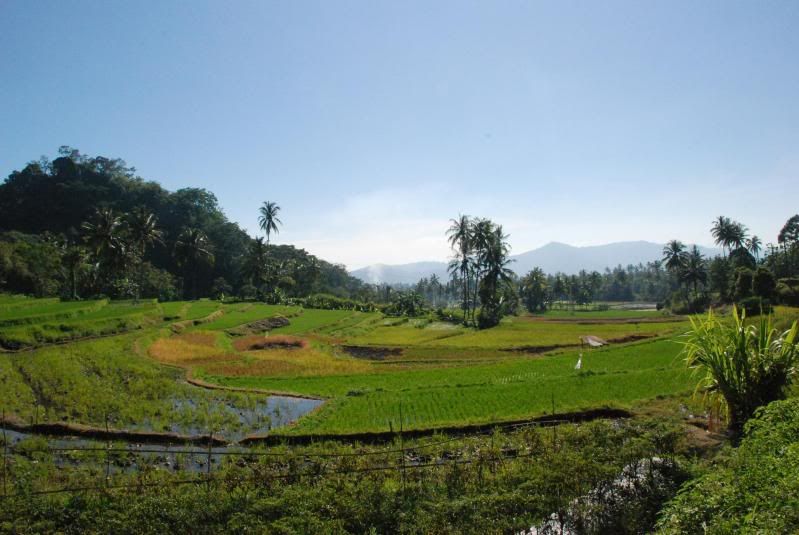
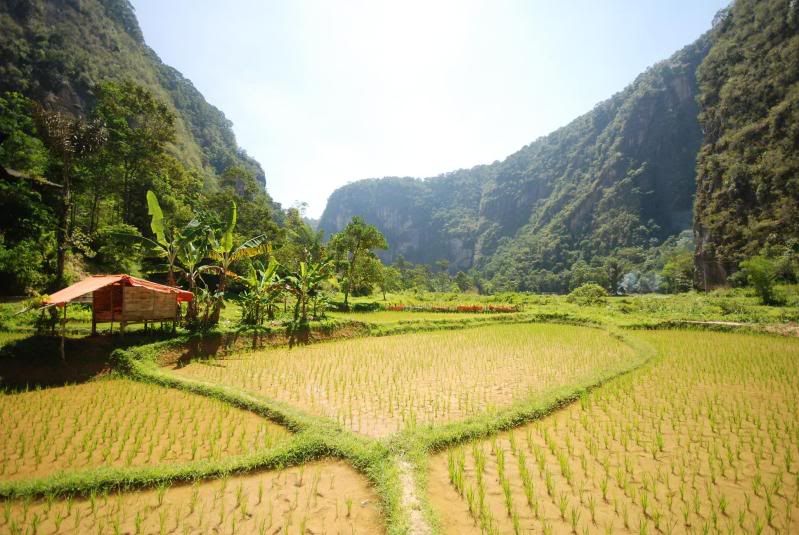
I had my own motorbike so that I could stay at the end of the day at Lake Maninjau, another volcanic lake near Bukittingi. We stopped at the top of the steep descent down to the lake via a series of 44 hairpin bends; the view was mostly obscured the haze generated by the smoke from fires burning in many rice paddies.
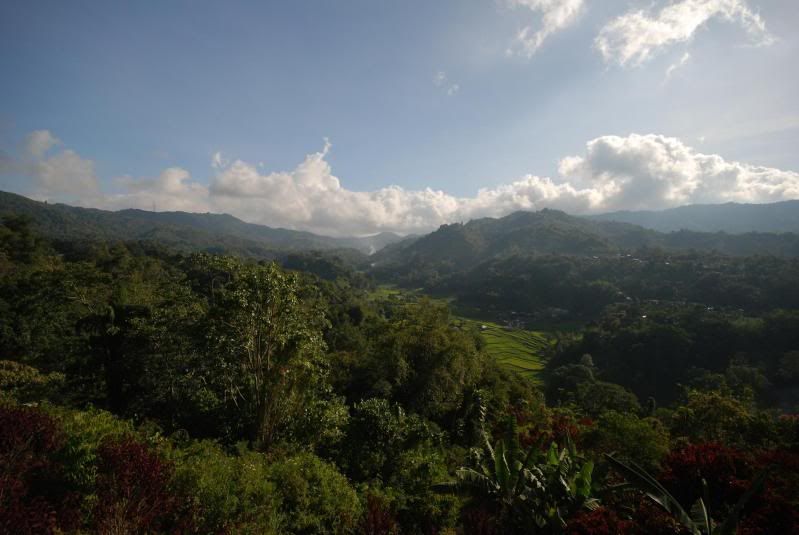
On the way to Lake Maninjau
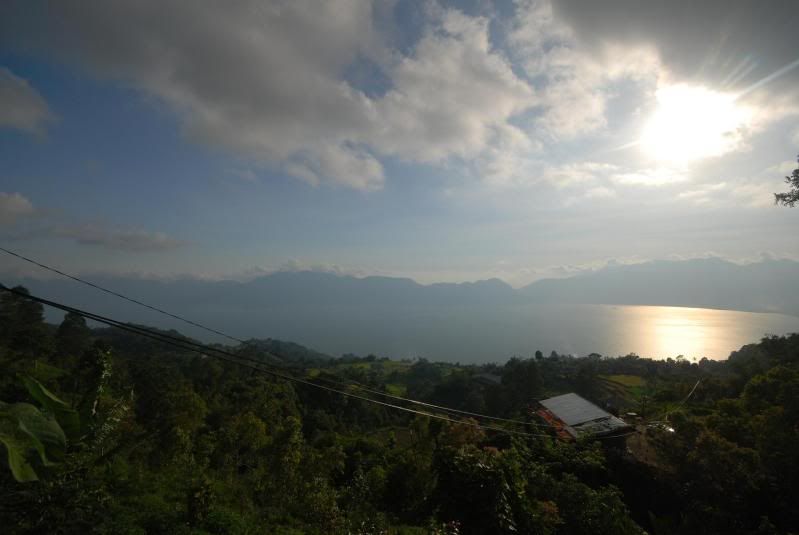
Once at the bottom we pulled into the Beach Inn Guest House, my home for the next couple of nights. There was a steady onshore breeze and small waves lapped at the beach, whilst inside the friendly owners cooked up a range of delicious local food. After dark, Janick and Inge headed back to Bukittingi with Fikar- they were flying home the next day - and I settled down to a couple of days of tourist free isolation, with only a range of poor secondhand books to keep me company. In the end I was relieved I had not decided to stay longer - there was an overwhelming smell of fish from the fish farms in the morning still; at about 1pm the wind started as if turned on by a switch. The best bit by farm was the excellent food.
I headed back to Bukittingi via the lookout over Lake Maninjau - still obscured by smoke - and after buying a few traditional boxes. The local people around Bukittingi are called Minangkabau, with yet another distinctive architectural style and set of traditions, mostly based around the strength of the water buffalo, and in particular, it's rather large horns. Local legend tells the story of the origin of the Minangkabau name whilst fighting Javanese invaders; rather than pitching two armies in battle against each other, they chose to declare the victor based on the outcome of a contest between two water buffalo. The local Sumatrans, knowing that the Javanese had a much stronger and more powerful animal, starved a week-old buffalo calf and laced it's horn buds with small razors which promptly eviscerated the larger animal as the calf desperately started looking for milk. Minangkabau, in local dialect, means "the buffalo is victorious".
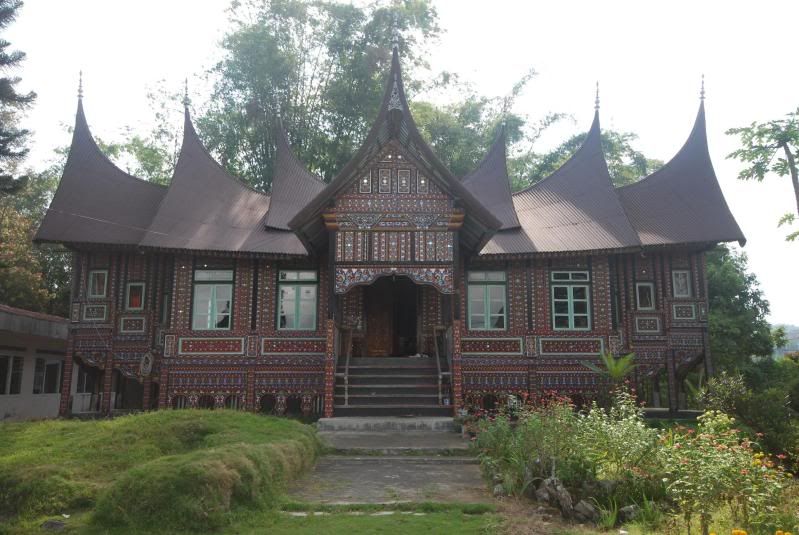
Traditional Minangkabau house
In Bukittingi I resolved to climb at least one of Sumatra's many active volcanoes; the one I chose was Merapi, which towers above the town to almost 3000m. We left at 11pm the following night, a small group of 4 of us who trudged slowly up through the cloud forest towards the summit. It was a long haul in the dark, but as we got above the tree line the views of Bukittingi were magnificent by night, we stopped for a very early breakfast to take in the view. By 6am we were on the summit and awaiting sunrise; it was a little cloudy but still very satisfying, and afterwards we walked around the still active crater that belched hydrogen sulphide and steam.
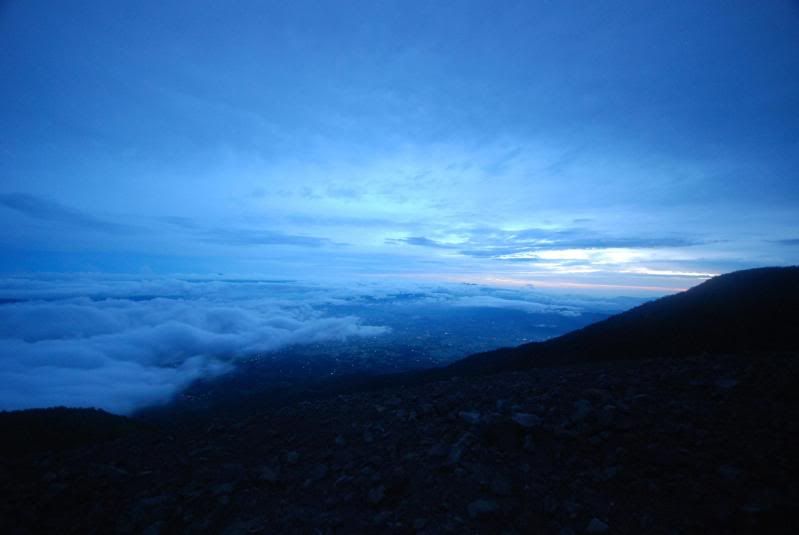
The cloud dropped down on us suddenly at about 7.30am, and we started the long descent as gentle rain started to fall. After an hour it became very heavy and with sodden clothes, aching legs and sore knees we eventually got back to Bukittingi in time for lunch and a well deserved sleep - I would leave for Singapore in the morning.
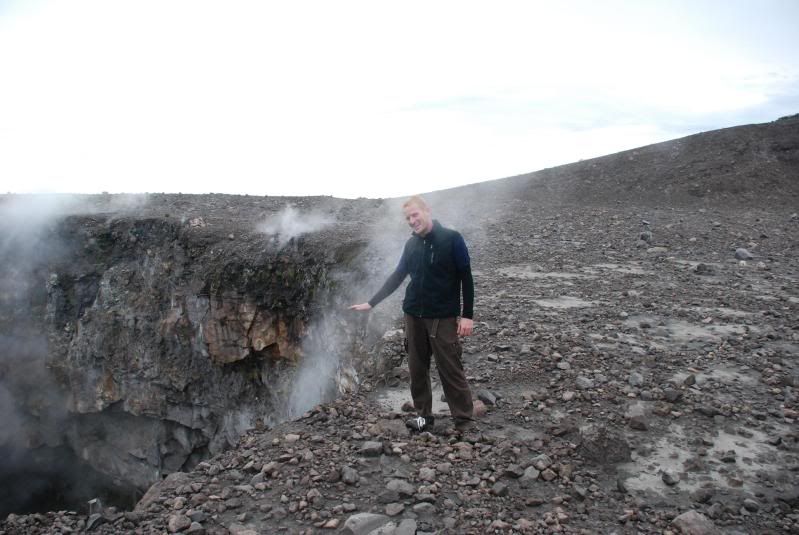
The following day was remarkable only for the speed of descent from the highlands to the coast near Padang, on the central west coast of Sumatra. It has long been the exit point for Sumatra, despite being barely half-way down it's length; that leaves over half of the an island as big as France unexplored. Padang is full of old Dutch colonial architecture that I missed; a few days previously Fikar had taken Janick around in search of family relatives who were thought to be based around Padang somewhere.
In the airport I saw more tourists in one day that I had done in on almost any other day in Sumatra. They were all surfers, mostly professional and sponsored by Red Bull, sickeningly good looking and all with beautiful girlfriends. I felt extremely inadequate.
In Singapore, I found and settled into a "boutique flashpackers" hostel close to Orchard Road, primarily because of it's proximity to the Indonesian embassy. It was also handily close to a doctor, which was lucky as I felt a little rough when I arrived, and rapidly developed what I thought (and the doctor thought) was a protozoal infection..... so far I've slept most of the time here. I'll let you know how it goes.
The bus ride was distinctly average. Sitting at the back of the bus next to the toilet, I had a friendly Belgian guy on one side, and a local woman with her hyperactive toddler on the other. It had aircon which was promptly turned onto "refrigerate" setting, and a thankful lack of karaoke machines. The Trans-Sumatran highway, for most of the 15 hour journey, would have been more aptly named the Trans-Sumatran farm track; once the child next to me settled down with hypothermia I lent the mother my sarong to keep the little nipper warm - she promptly vomited on her child and used my sarong to wipe it up (and didn't tell me). As I said, average.
Bukittingi is another town with guide-overload and tourist underload; even as we headed up to a cafe from the bus terminal for breakfast, we were "shown" in by a guy who had followed us up the other side of the street then acted like he brought us there, earning himself a little commission in the process. Bukittingi is a fairly unremarkable town but it's surroundings are much nicer - very similar to Berastagi. After a kip our little gang - 3 Belgian lads, Inge, Janick and myself - headed around the market, which saw few enough white people to make this an absolutely hilarious occurrence for many. Once again, the fresh chicken was available "while-u-wait" - simply pick your chicken as it pecks around the cage, look the other way and... hey presto! A fully sliced and diced chicken.... "would you like the giblets with that mister???"



After the Belgian boys moved on and I washed my sarong and slept, I headed off with the girls on a day tour of the area with Fikar, a local guide who worked from a cafe as part of a co-op - we were happy to give him our money. The girls went as passengers on motorbikes; I had my own and we were soon cruising through rice paddies on our way to the Harau Valley, a spectacularly picturesque valley made of some kind of rock that I can't remember. Fikar was pleased that I seemed to be able to drive faster than 40km/h, even whilst wearing a comedy helmet made mostly of duct tape.


I had my own motorbike so that I could stay at the end of the day at Lake Maninjau, another volcanic lake near Bukittingi. We stopped at the top of the steep descent down to the lake via a series of 44 hairpin bends; the view was mostly obscured the haze generated by the smoke from fires burning in many rice paddies.

On the way to Lake Maninjau

Once at the bottom we pulled into the Beach Inn Guest House, my home for the next couple of nights. There was a steady onshore breeze and small waves lapped at the beach, whilst inside the friendly owners cooked up a range of delicious local food. After dark, Janick and Inge headed back to Bukittingi with Fikar- they were flying home the next day - and I settled down to a couple of days of tourist free isolation, with only a range of poor secondhand books to keep me company. In the end I was relieved I had not decided to stay longer - there was an overwhelming smell of fish from the fish farms in the morning still; at about 1pm the wind started as if turned on by a switch. The best bit by farm was the excellent food.
I headed back to Bukittingi via the lookout over Lake Maninjau - still obscured by smoke - and after buying a few traditional boxes. The local people around Bukittingi are called Minangkabau, with yet another distinctive architectural style and set of traditions, mostly based around the strength of the water buffalo, and in particular, it's rather large horns. Local legend tells the story of the origin of the Minangkabau name whilst fighting Javanese invaders; rather than pitching two armies in battle against each other, they chose to declare the victor based on the outcome of a contest between two water buffalo. The local Sumatrans, knowing that the Javanese had a much stronger and more powerful animal, starved a week-old buffalo calf and laced it's horn buds with small razors which promptly eviscerated the larger animal as the calf desperately started looking for milk. Minangkabau, in local dialect, means "the buffalo is victorious".

Traditional Minangkabau house
In Bukittingi I resolved to climb at least one of Sumatra's many active volcanoes; the one I chose was Merapi, which towers above the town to almost 3000m. We left at 11pm the following night, a small group of 4 of us who trudged slowly up through the cloud forest towards the summit. It was a long haul in the dark, but as we got above the tree line the views of Bukittingi were magnificent by night, we stopped for a very early breakfast to take in the view. By 6am we were on the summit and awaiting sunrise; it was a little cloudy but still very satisfying, and afterwards we walked around the still active crater that belched hydrogen sulphide and steam.

The cloud dropped down on us suddenly at about 7.30am, and we started the long descent as gentle rain started to fall. After an hour it became very heavy and with sodden clothes, aching legs and sore knees we eventually got back to Bukittingi in time for lunch and a well deserved sleep - I would leave for Singapore in the morning.

The following day was remarkable only for the speed of descent from the highlands to the coast near Padang, on the central west coast of Sumatra. It has long been the exit point for Sumatra, despite being barely half-way down it's length; that leaves over half of the an island as big as France unexplored. Padang is full of old Dutch colonial architecture that I missed; a few days previously Fikar had taken Janick around in search of family relatives who were thought to be based around Padang somewhere.
In the airport I saw more tourists in one day that I had done in on almost any other day in Sumatra. They were all surfers, mostly professional and sponsored by Red Bull, sickeningly good looking and all with beautiful girlfriends. I felt extremely inadequate.
In Singapore, I found and settled into a "boutique flashpackers" hostel close to Orchard Road, primarily because of it's proximity to the Indonesian embassy. It was also handily close to a doctor, which was lucky as I felt a little rough when I arrived, and rapidly developed what I thought (and the doctor thought) was a protozoal infection..... so far I've slept most of the time here. I'll let you know how it goes.

No comments:
Post a Comment